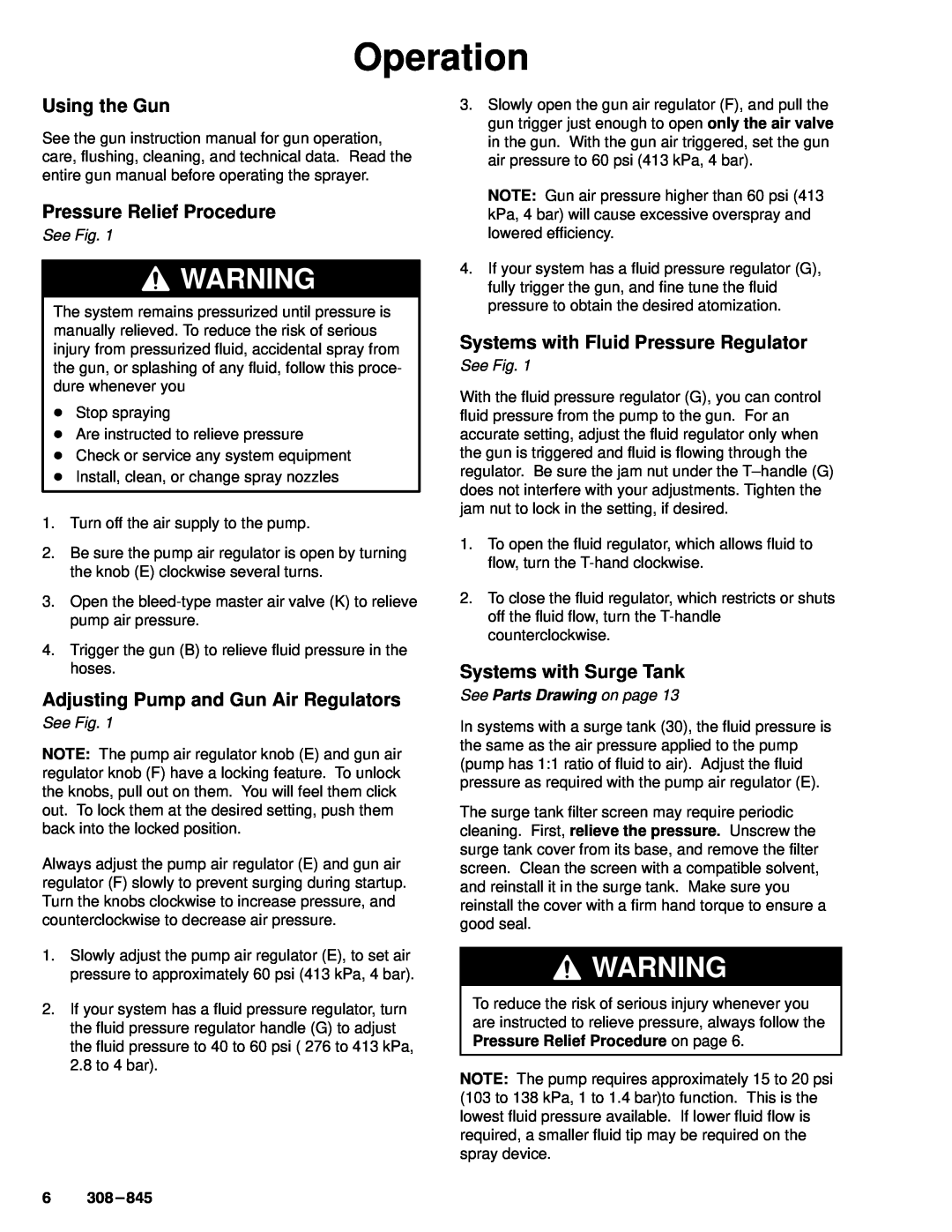
Operation
Using the Gun
See the gun instruction manual for gun operation, care, flushing, cleaning, and technical data. Read the entire gun manual before operating the sprayer.
Pressure Relief Procedure
See Fig. 1
![]() WARNING
WARNING
The system remains pressurized until pressure is manually relieved. To reduce the risk of serious injury from pressurized fluid, accidental spray from the gun, or splashing of any fluid, follow this proce- dure whenever you
DStop spraying
DAre instructed to relieve pressure
DCheck or service any system equipment
DInstall, clean, or change spray nozzles
1.Turn off the air supply to the pump.
2.Be sure the pump air regulator is open by turning the knob (E) clockwise several turns.
3.Open the
4.Trigger the gun (B) to relieve fluid pressure in the hoses.
Adjusting Pump and Gun Air Regulators
See Fig. 1
NOTE: The pump air regulator knob (E) and gun air regulator knob (F) have a locking feature. To unlock the knobs, pull out on them. You will feel them click out. To lock them at the desired setting, push them back into the locked position.
Always adjust the pump air regulator (E) and gun air regulator (F) slowly to prevent surging during startup. Turn the knobs clockwise to increase pressure, and counterclockwise to decrease air pressure.
1.Slowly adjust the pump air regulator (E), to set air pressure to approximately 60 psi (413 kPa, 4 bar).
2.If your system has a fluid pressure regulator, turn the fluid pressure regulator handle (G) to adjust the fluid pressure to 40 to 60 psi ( 276 to 413 kPa, 2.8 to 4 bar).
3.Slowly open the gun air regulator (F), and pull the gun trigger just enough to open only the air valve in the gun. With the gun air triggered, set the gun air pressure to 60 psi (413 kPa, 4 bar).
NOTE: Gun air pressure higher than 60 psi (413 kPa, 4 bar) will cause excessive overspray and lowered efficiency.
4.If your system has a fluid pressure regulator (G), fully trigger the gun, and fine tune the fluid pressure to obtain the desired atomization.
Systems with Fluid Pressure Regulator
See Fig. 1
With the fluid pressure regulator (G), you can control fluid pressure from the pump to the gun. For an accurate setting, adjust the fluid regulator only when the gun is triggered and fluid is flowing through the regulator. Be sure the jam nut under the
1.To open the fluid regulator, which allows fluid to flow, turn the
2.To close the fluid regulator, which restricts or shuts off the fluid flow, turn the
Systems with Surge Tank
See Parts Drawing on page 13
In systems with a surge tank (30), the fluid pressure is the same as the air pressure applied to the pump (pump has 1:1 ratio of fluid to air). Adjust the fluid pressure as required with the pump air regulator (E).
The surge tank filter screen may require periodic cleaning. First, relieve the pressure. Unscrew the surge tank cover from its base, and remove the filter screen. Clean the screen with a compatible solvent, and reinstall it in the surge tank. Make sure you reinstall the cover with a firm hand torque to ensure a good seal.
![]() WARNING
WARNING
To reduce the risk of serious injury whenever you are instructed to relieve pressure, always follow the Pressure Relief Procedure on page 6.
NOTE: The pump requires approximately 15 to 20 psi (103 to 138 kPa, 1 to 1.4 bar)to function. This is the lowest fluid pressure available. If lower fluid flow is required, a smaller fluid tip may be required on the spray device.
6
